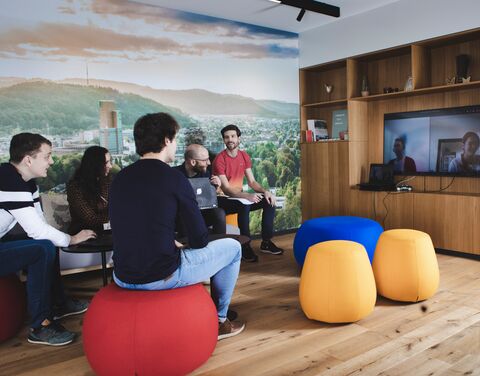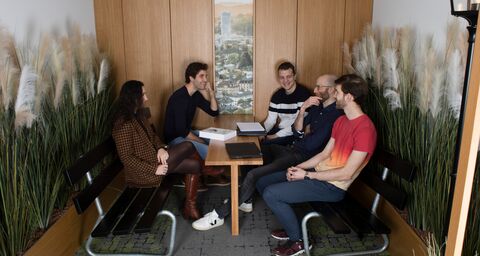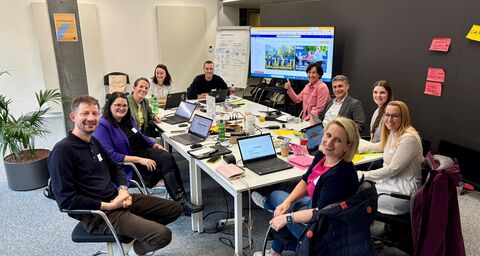
Clever and flexible: AXA’s Smart Working concept
AXA’s work culture is defined by its agility and flexibility. Smart Working is one concept that fosters this culture. With this modern work model, time spent together in the office is used in a targeted way for sharing ideas, creativity and collaboration, while time spent in a home office or another suitable place allows for concentrated work and flexibility.
Smart Working
Trust, flexibility and teamwork are key concepts at AXA – ones we live everyday. Our Smart Working model focuses on company objectives rather than the location where employees do their work. But it goes without saying that our customers and their needs always come first. The pandemic showed us that letting staff work from home is a recipe for success. But we at AXA have known this for quite a while, which is why we offer this flexible work option.
Where is the best place to work?
The ideal place to work is where productivity is highest, collaboration works best and where as many personal preferences as possible can be taken into account.
A portrait of two of our teams
Below we introduce two of our teams and their optimal workspace. They will talk about their workday and their experience with our Smart Working concept. One team is agile and the other is very operations oriented.
It’s the content that matters, not the place
The best aspect of the Smart Working concept for both teams is the flexibility.
“We use the Kanban agile method of process management. The level of transparency it provides enables all of us in the team to always know who’s working on what and how tasks are allocated,” explains Savo. Everyone knows that transparency is the key to putting the Smart Working concept into practice. “We all trust one another. Each and every one of us knows at any given time who is working on what.”
The new flexible working model also has many advantages for Roy’s operations team. “Smart Working has a very positive impact on work-life balance. But you can’t forget that if you work from home you still need to have a clear separation from your work life,” says Roy. One thing’s clear, though. Although the line between personal life and work life is becoming increasingly blurred, the mutual trust among team members has not changed. The Smart Working concept gives all employees greater flexibility in every project and every phase of their work.
Everyone agrees that where, when and how much they all work is not the key focus.
Main features of Smart Working
- The team decides together on how they will work: online, in person or a mix of both.
- Flexible choice of work location: AXA offices, at home or in a place where you feel comfortable.
- The time spent together in the office is used mainly for creative and personal exchanges.
- Regular team meetings in the office shore up personal contacts and promote cooperation.
- Work/life balance is enhanced thanks to the greater freedom employees are given to organize their working hours.
Employees can choose the number of fixed team days
Both teams have defined what exactly Smart Working means for them and how it should work. Each individual model meets both the needs of AXA customers and the tasks that each team needs to complete.
The Reserving & Valuation Individual Life team decides together on which days of the week they want to spend in the office. Team day is all about collaboration and the exchange of ideas: “On team day we all make an effort to promote informal and casual interaction. We all go out to eat and laugh a lot together,” explain the members of Savo’s team. It’s easy to tell that coming together on a set day like this does a lot to build morale within the team. On the remaining weekdays, staff can organize their work as they choose based on personal preferences.
But Smart Working wouldn’t be “smart” if the concept itself wasn’t flexible and intelligent enough to adapt to the latest technologies and challenges. “Our model is constantly being evaluated and updated. We want to remain agile and flexible,” say the members of Savo’s team.
“On team day we all make an effort to promote informal and casual interaction. We all go out to eat and we also laugh a lot together.”
The Motor Vehicle Underwriting team has also set aside a team day, but under completely different conditions. With their very operations-oriented workday, they need to be constantly available for their customers during official service hours. This is the absolute top priority. Their day is not really tied up with meetings, but rather with complex operational processes. Team days ensure that all team members are on site on the same day. The point of this is to strengthen the team and promote personal contact. But daily business still needs to be taken care of. “For us, the main point is to be together in the office. This makes it a lot easier to ask a quick question or go have a coffee together,” explains Roy.
People are what count
“Of course, there are also challenges,” admit both Savo and Roy. One is to keep the information flowing optimally in the team. Coordinating individual employees with one another and in the team using more and more online tools brings with it many new challenges.
“Sometimes we miss being able to just get up and go to someone’s desk and ask a quick question or discuss a problem.” But both agree that the atmosphere on office days is now much better and less complicated. “What can’t be replaced virtually is definitely physical human interaction – a gesture, a smile or an encouraging nod,” says Savo, adding that he finds it difficult in online meetings to tell when someone on his team is not doing well. This makes it all the more important to have informal discussions when staff get together at the office.
A triple win for AXA
With greater productivity, flexibility and employee satisfaction, there’s no doubt that the Smart Working flexible work concept is a win-win-win for AXA, for our employees and for our customers. Mutual trust certainly pays off. Three times over, in fact.







